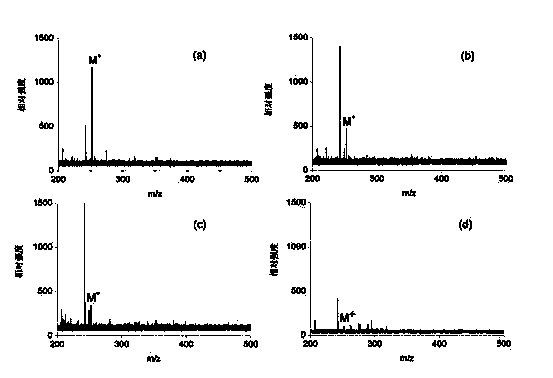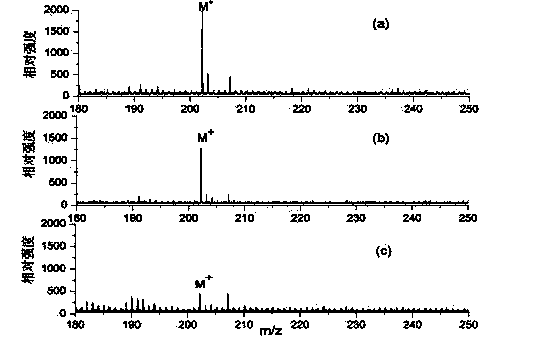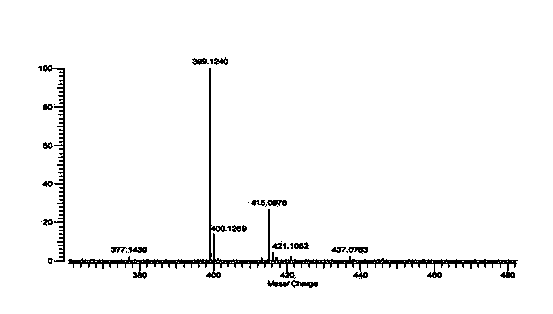Application of tungsten disulfide in laser desorption ionization mass spectrometric detection
A technology of laser desorption ionization and tungsten disulfide, applied in measuring devices, material analysis through electromagnetic means, instruments, etc., can solve the problems of difficult formation of matrix layer, poor spectrum reproducibility, complicated preparation, etc., and avoid surface irregularities. Uniform, reproducible, uniform surface layer effect
- Summary
- Abstract
- Description
- Claims
- Application Information
AI Technical Summary
Problems solved by technology
Method used
Image
Examples
Embodiment 1
[0026] Detection of Benzo[k]fluoranthene Using Tungsten Disulfide as SALDI Surface Material
[0027] 1) Add a concentration of 0.1mg / mLWS 2 Suspension, ultrasonic vibration for 5 minutes. Take 1 μL of the suspension and quickly spot it on the sample target, and dry it at room temperature.
[0028] 2) Under the same conditions, use the same method to prepare a total of twelve targets as a reference. Divide every three targets into one group, a total of four groups.
[0029] 3) Add 1 μL of BkF solutions with concentrations of 100 μg / mL, 10 μg / mL, 1 μg / mL, and 0.1 μg / mL dropwise on the four groups of targets, and dry at room temperature. After drying, it is sent to the instrument for detection.
[0030] 4) Set the laser intensity to 60%, move randomly on the same sample point, bombard the sample with laser 2000 times continuously, and superimpose the results of multiple times to get the general picture.
[0031] figure 1 To analyze the mass spectra of benzo[k]fluoranthene ...
Embodiment 2
[0033] Detection of Pyrene Using Tungsten Disulfide as SALDI Surface Material
[0034] 1) The concentration of 0.1mg / mL tungsten disulfide suspension, ultrasonic vibration for 5 minutes. Take 1 μL of the suspension and quickly spot it on the sample target, and dry it at room temperature.
[0035] 2) Under the same conditions, use the same method to prepare a total of nine targets as a reference. Every three targets were divided into one group, a total of three groups.
[0036] 3) Add 1 μL of pyrene solutions with concentrations of 100 μg / mL, 10 μg / mL, and 1 μg / mL dropwise on the three groups of targets, and dry at room temperature. After drying, it is sent to the instrument for detection.
[0037] 4) Set the laser intensity to 60%, move randomly on the same sample point, bombard the sample with laser 2000 times continuously, and superimpose the results of multiple times to get the general picture.
[0038] figure 2 In order to analyze the mass spectrograms of different c...
Embodiment 3
[0040] Study on Riboflavin Using Tungsten Disulfide as SALDI Surface Material
[0041] 1) Using deionized water as a solvent, prepare a riboflavin solution with a concentration of 200 μM (containing 20 μM sodium chloride and 20 μM potassium chloride), and adjust the pH of the solution to 5 with acetic acid to ensure that riboflavin can Stable in aqueous solution;
[0042] 2) Take 0.5 μL tungsten disulfide solution and spot on the sample target, dry at room temperature and form a thin layer of matrix;
[0043] 3) Take 0.5 μL of the prepared riboflavin sample solution and spot it on the dried tungsten disulfide film, and dry it at room temperature;
[0044] 4) Send the prepared sample to the mass spectrometer for analysis.
[0045] image 3 To study the mass spectrum of riboflavin with tungsten disulfide as surface-assisted laser desorption ionization (SALDI) surface material. The figure shows that when tungsten disulfide is used as the surface material of SALDI, riboflavin ...
PUM
 Login to View More
Login to View More Abstract
Description
Claims
Application Information
 Login to View More
Login to View More - R&D
- Intellectual Property
- Life Sciences
- Materials
- Tech Scout
- Unparalleled Data Quality
- Higher Quality Content
- 60% Fewer Hallucinations
Browse by: Latest US Patents, China's latest patents, Technical Efficacy Thesaurus, Application Domain, Technology Topic, Popular Technical Reports.
© 2025 PatSnap. All rights reserved.Legal|Privacy policy|Modern Slavery Act Transparency Statement|Sitemap|About US| Contact US: help@patsnap.com



